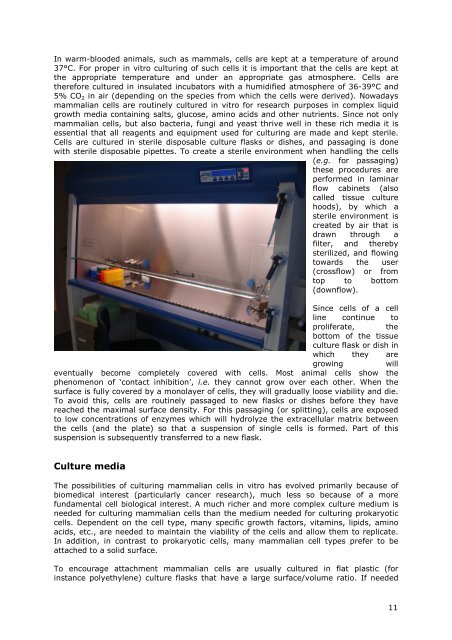production of animal proteins by cell systems - New Harvest
production of animal proteins by cell systems - New Harvest
production of animal proteins by cell systems - New Harvest
You also want an ePaper? Increase the reach of your titles
YUMPU automatically turns print PDFs into web optimized ePapers that Google loves.
In warm-blooded <strong>animal</strong>s, such as mammals, <strong>cell</strong>s are kept at a temperature <strong>of</strong> around<br />
37°C. For proper in vitro culturing <strong>of</strong> such <strong>cell</strong>s it is important that the <strong>cell</strong>s are kept at<br />
the appropriate temperature and under an appropriate gas atmosphere. Cells are<br />
therefore cultured in insulated incubators with a humidified atmosphere <strong>of</strong> 36-39°C and<br />
5% CO2 in air (depending on the species from which the <strong>cell</strong>s were derived). Nowadays<br />
mammalian <strong>cell</strong>s are routinely cultured in vitro for research purposes in complex liquid<br />
growth media containing salts, glucose, amino acids and other nutrients. Since not only<br />
mammalian <strong>cell</strong>s, but also bacteria, fungi and yeast thrive well in these rich media it is<br />
essential that all reagents and equipment used for culturing are made and kept sterile.<br />
Cells are cultured in sterile disposable culture flasks or dishes, and passaging is done<br />
with sterile disposable pipettes. To create a sterile environment when handling the <strong>cell</strong>s<br />
(e.g. for passaging)<br />
these procedures are<br />
performed in laminar<br />
flow cabinets (also<br />
called tissue culture<br />
hoods), <strong>by</strong> which a<br />
sterile environment is<br />
created <strong>by</strong> air that is<br />
drawn through a<br />
filter, and there<strong>by</strong><br />
sterilized, and flowing<br />
towards the user<br />
(crossflow) or from<br />
top to bottom<br />
(downflow).<br />
Since <strong>cell</strong>s <strong>of</strong> a <strong>cell</strong><br />
line continue to<br />
proliferate, the<br />
bottom <strong>of</strong> the tissue<br />
culture flask or dish in<br />
which they are<br />
growing will<br />
eventually become completely covered with <strong>cell</strong>s. Most <strong>animal</strong> <strong>cell</strong>s show the<br />
phenomenon <strong>of</strong> ‘contact inhibition’, i.e. they cannot grow over each other. When the<br />
surface is fully covered <strong>by</strong> a monolayer <strong>of</strong> <strong>cell</strong>s, they will gradually loose viability and die.<br />
To avoid this, <strong>cell</strong>s are routinely passaged to new flasks or dishes before they have<br />
reached the maximal surface density. For this passaging (or splitting), <strong>cell</strong>s are exposed<br />
to low concentrations <strong>of</strong> enzymes which will hydrolyze the extra<strong>cell</strong>ular matrix between<br />
the <strong>cell</strong>s (and the plate) so that a suspension <strong>of</strong> single <strong>cell</strong>s is formed. Part <strong>of</strong> this<br />
suspension is subsequently transferred to a new flask.<br />
Culture media<br />
The possibilities <strong>of</strong> culturing mammalian <strong>cell</strong>s in vitro has evolved primarily because <strong>of</strong><br />
biomedical interest (particularly cancer research), much less so because <strong>of</strong> a more<br />
fundamental <strong>cell</strong> biological interest. A much richer and more complex culture medium is<br />
needed for culturing mammalian <strong>cell</strong>s than the medium needed for culturing prokaryotic<br />
<strong>cell</strong>s. Dependent on the <strong>cell</strong> type, many specific growth factors, vitamins, lipids, amino<br />
acids, etc., are needed to maintain the viability <strong>of</strong> the <strong>cell</strong>s and allow them to replicate.<br />
In addition, in contrast to prokaryotic <strong>cell</strong>s, many mammalian <strong>cell</strong> types prefer to be<br />
attached to a solid surface.<br />
To encourage attachment mammalian <strong>cell</strong>s are usually cultured in flat plastic (for<br />
instance polyethylene) culture flasks that have a large surface/volume ratio. If needed<br />
11



